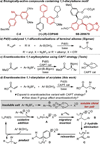Development and Analysis of a Pd(0)-Catalyzed Enantioselective 1,1-Diarylation of Acrylates Enabled by Chiral Anion Phase Transfer
- PMID: 27960315
- PMCID: PMC5217716
- DOI: 10.1021/jacs.6b11367
Development and Analysis of a Pd(0)-Catalyzed Enantioselective 1,1-Diarylation of Acrylates Enabled by Chiral Anion Phase Transfer
Abstract
Enantioselective 1,1-diarylation of terminal alkenes enabled by the combination of Pd catalysis with a chiral anion phase transfer (CAPT) strategy is reported herein. The reaction of substituted benzyl acrylates with aryldiazonium salts and arylboronic acids gave the corresponding 3,3-diarylpropanoates in moderate to good yields with high enantioselectivies (up to 98:2 er). Substituents on the benzyl acrylate and CAPT catalyst significantly affect the enantioselectivity, and multidimensional parametrization identified correlations suggesting structural origins for the high stereocontrol.
Figures
References
-
-
For reviews, see: Jensen KH, Sigman MS. Org. Biomol. Chem. 2008;6:4083. McDonald RI, Liu G, Stahl SS. Chem. Rev. 2011;111:2981.
-
-
-
For recent reviews, see: Ameen D, Snape TJ. Med. Chem. Commun. 2013;4:893. For examples, see: Alexander RP, Warrellow GJ, Eaton MAW, Boyd EC, Head JC, Porter JR, Brown JA, Reuberson JT, Hutchinson B, Turner P, Boyce B, Barnes D, Mason B, Cannell A, Taylor RJ, Zomaya A, Millican A, Leonard J, Morphy R, Wales M, Perry M, Allen RA, Gozzard N, Hughes B, Higgs G. Bioorganic Med. Chem. Lett. 2002;12:1451. Ohlstein EH, Nambi P, Douglas SA, Edwards RM, Gellai M, Lago A, Leber JD, Cousins RD, Gao A, Frazee JS, Peishoff CE, Bean JW, Eggleston DS, Elshourbagy NA, Kumar C, Lee JA, Yue T-L, Louden C, Brooks DP, Weinstock J, Feuerstein G, Poste G, Ruffolo RR, Gleason JG, Elliott JD. Proc. Natl. Acad. Sci. U. S. A. 1994;91:8052. Hyttel J, Larsen JJ. J. Neurochem. 1985;44:1615.
-
-
-
Nelson HM, Williams BD, Miró J, Toste FD. J. Am. Chem. Soc. 2015;137:3213. For reviews on chiral ion pairs used in catalysis, see: Phipps RJ, Hamilton GL, Toste FD. Nature Chem. 2012;4:603. Brak K, Jacobsen EN. Angew. Chem. Int. Ed. 2013;52:534.
-
Publication types
MeSH terms
Substances
Grants and funding
LinkOut - more resources
Full Text Sources
Other Literature Sources




